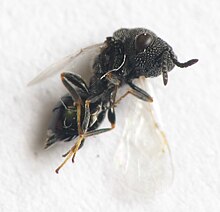Eurytomidae
| Eurytomidae | |
|---|---|

| |
| Scientific classification | |
| Domain: | Eukaryota |
| Kingdom: | Animalia |
| Phylum: | Arthropoda |
| Class: | Insecta |
| Order: | Hymenoptera |
| Superfamily: | Chalcidoidea |
| Family: | Eurytomidae Walker,1832 |
| Subfamilies | |
| Diversity | |
| Four subfamilies c.85 genera c.1420 species | |
TheEurytomidaeare a family within the superfamilyChalcidoidea.
Unlike most chalcidoids, thelarvaeof many arephytophagous(feeding in stems, seeds, orgalls), while others are more typicalparasitoids,though even then the hosts are usually found within plant tissues. Some species of eurytomids are unusual in the sense that they are parasitoids of spider eggs. Females of this group areidiobiontsthat probe through the thin silk of spider egg sacs and oviposit into individual spider eggs that are clustered within the sacs.[1]
They are found throughout the world in virtually all habitats, and a few are considered pests.
They tend to be dull and not metallic, and heavily punctured, with very thick, collar-likepronota.
Taxa
[edit]
As of 2021[update],Eurytomid genera include:[2]
BuresiinaeLotfalizadeh et al., 2007[3]
- BuresiumBoucek, 1969
- MacrorileyaAshmead, 1900
EurytominaeWalker, 1832
- AiolomorphusWalker, 1871
- AranedraBurks, 1971
- AustrodecatomaGirault, 1925
- AusystoleBoucek, 1988
- AxanthosomaGirault, 1913
- AxanthosomellaNarendran, 2001
- AximaWalker, 1862
- AximopsisAshmead, 1904
- BanyomaBurks, 1971
- BephrataCameron, 1884
- BephratelloidesGirault, 1913
- BephratoidesBrues, 1909
- BruchodapeBurks, 1971
- BruchophagusAshmead, 1888
- BurksomaSubba Rao, 1978
- CamponotophilusGates, 2012
- CathilariaBurks, 1971
- ChryseidaSpinola, 1840
- ChryseurytomaChen & Huang, 2004
- EndobiaErdos, 1964
- EudoxinnaWalker, 1864
- EurytomaIlliger, 1807
- EurytomocharisAshmead, 1888
- ExeurytomaBurks, 1971
- FicomilaBoucek, 1981
- FoutsiaBurks, 1971
- FronsomaNarendran, 1994
- GibsonomaNarendran, 1994
- GiraultomaBoucek, 1988
- HeimbrellaSubba Rao, 1978
- HexeurytomaDodd, 1917
- HomodecatomaLiao, 1979
- HoustoniaBoucek, 1988
- IsosomodesAshmead, 1888
- KavayvaZhang, Gates, & Silvestre 2021
- KhamulGates, 2008
- MangomaSubbaRao, 1986
- MasneromaBoucek, 1983
- NeobephrataNarendran & Padmasenan, 1989
- ParabruchophagusZerova, 1992
- ParadecatomaMasi, 1943
- PhilippinomaNarendran, 1994
- PhilolemaCameron, 1908
- PhleudecatomaYang, 1996
- PhylloxeroxenusAshmead, 1888
- PlutarchiaGirault, 1925
- ProdecatomaAshmead, 1904
- ProdecatomideaRisbec, 1952
- ProseurytomaKieffer, 1910
- PseudotetramesaKalina, 1970
- RamanujaNarendran, 1989
- RamdasomaNarendran, 1994
- RisbecomaSubbaRao, 1978
- StigmeurytomaBoucek, 1988
- SyceurytomaBoucek, 1981
- SycophilaWalker, 1871
- SystoleWalker, 1832
- SystolemaNarendran, 1994
- TenuipetiolusBugbee, 1951
- TetramesaWalker, 1848
- TetramesellaZerova, 1974
- TownesomaNarendran, 1994
- ZerovellaNarendran & Sheela, 1994
HeimbrinaeBurks, 1971
RileyinaeAshmead, 1904
- AustrophotismusGirault, 1938
- BoucekianaDe Santis, 1975
- DougiolaBoucek, 1988
- GatesinaPujade-Villar et al., 2018
- NeorileyaAshmead, 1904
- PlatyrileyaBurks, 1971
- RileyaAshmead, 1888
References
[edit]- ^Fei, Minghui; Gols, Rieta; Harvey, Jeffrey A. (2023-01-23)."The Biology and Ecology of Parasitoid Wasps of Predatory Arthropods".Annual Review of Entomology.68(1): 109–128.doi:10.1146/annurev-ento-120120-111607.hdl:20.500.11755/8f020f3d-b12d-4d23-8c07-eae6302721b8.ISSN0066-4170.PMID36198401.S2CID252736581.
- ^Noyes, J. S. (March 2019)."Universal Chalcidoidea Database".RetrievedJune 1,2021.
- ^LOTFALIZADEH, HOSSEINALI; DELVARE, GÉRARD; RASPLUS, JEAN-YVES (November 2007)."Phylogenetic analysis of Eurytominae (Chalcidoidea: Eurytomidae) based on morphological characters".Zoological Journal of the Linnean Society.151(3): 441–510.doi:10.1111/j.1096-3642.2007.00308.x.ISSN1096-3642.
External links
[edit]- Universal Chalcidoidea Database
- Cedar CreekArchived2008-07-05 at theWayback MachinePinned specimen images.
- Philolema latrodecti(Fullaway)on theUF/IFASFeatured Creatures Web site
- Bugguide.net. Family Eurytomidae
